





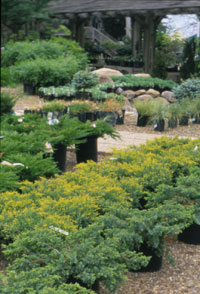
As you walk through the nursery, you'll discover that plants are available in three forms: balled-and-burlapped (typically bigger trees and shrubs with burlap wrapped around the root balls), bare-root (usually hedge plants and roses), and in containers (annuals, perennials, and smaller shrubs and trees). Plants are also grown differently: Some are kept in fields, some in containers; some start out in fields and are then transplanted to containers to be sold.
Nurseries often grow trees and shrubs in their fields, where the plants are generally easier to maintain and can grow to a larger size than if they are kept in containers. Field-grown stock needs to be dug up in winter and early spring (before breaking dormancy), wrapped in burlap and twine (and even metal cages in the case of large trees), then shipped to the sales center. These balled-and-burlapped plants may lose up to 90 percent of their root systems, but this method is the only way to offer very large plants for sale.
Once you've chosen the best plants, learn the importance of soil to their growth.
continue reading below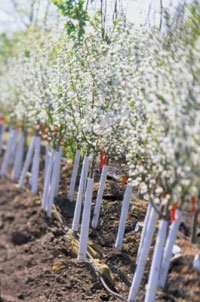 Before choosing trees, make
sure to read the tag, which
will list the mature height and
spread of the plant.
Before choosing trees, make
sure to read the tag, which
will list the mature height and
spread of the plant.
Bare-root stock is dug from the fields during its dormant season (late fall to very early spring) and placed in cold storage. Because there is no dirt surrounding the root system, bare-root trees and shrubs are light and easy to transport (as well as transplant), and they cost less than either container-grown or balled-and-burlapped plants.
In early spring (or late fall in temperate zones), nurseries may offer bare-root plants in batches of 50 or 100 for hedges such as lilacs. As a general rule, however, bare-root stock isn't offered at nurseries because the plants break dormancy and begin growing when removed from cold storage. Bare-root plants are ideal for mail-order nurseries, where they are kept in the "suspended animation" of cold storage and shipped to you in time for immediate planting. Buying roses as bare-root plants from a single source means there's less chance of bringing home a fungal disease.
Container-grown stock starts life in a container. As the plant gets larger, the grower transplants it to larger containers. The more years spent in containers, the more time and money the grower has spent on the plant, which explains why some container-grown plants are very expensive. For example, dwarf conifers, some of which are notoriously slow-growing, spend several years in containers before they grow large enough to be sold.
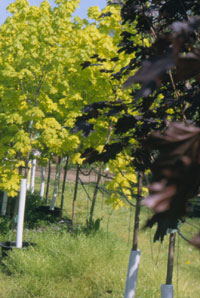
You can learn a lot at the nursery merely by comparing the available plants. Let's say you want to purchase a river birch (Betula nigra), and your nursery has 10 of them in the size you want. They're 8 to 10 feet high and feature substantial trunks that are beginning to show the peeling characteristic of a mature river birch. At $229 apiece, they aren't cheap, but they offer immediate landscape satisfaction.
Examine the 10 trees. Some may have only one trunk, whereas others may have two, three, four, or five (or more). Let's say you want a classic three-trunker, and six of the trees meet this criterion. One might feature pale green leaves, whereas the others are a healthy midgreen; disregard the pale green version (it is probably nitrogen-starved). Two of the trees might have root balls smaller than the other three; disregard them. Perhaps one of the remaining three trees has a large root protruding from the burlap and seems rather dried out and distressed; disregard it. Look at the remaining two river birches. Either choice is probably right, but one will simply whisper "Take me home!"
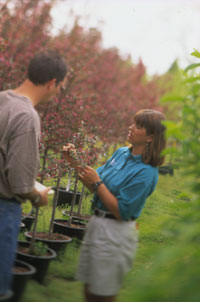 Nursery staff members are
a valuable resource when
choosing the right plant
for your needs.
Nursery staff members are
a valuable resource when
choosing the right plant
for your needs.
If you want to know whether a tree will grow too tall for your yard, here's a quick rule of thumb: To keep trees in scale with a house, they should be no more than one-fourth to one-third taller than the roof. If you have a ranch house or other one-story design (with a height of 12 to 15 feet), the mature height of trees planted nearby should be no more than 15 to 20 feet. A two-story house (with a height of 18 to 22 feet), however, can handle taller trees, about 22 to 30 feet at maturity. Plant the taller trees you desire on the periphery of your yard, where they will not overpower your house.
Of course, you may decide you'd rather purchase the next size smaller river birch at $149 so you can spend the $80 difference on three azaleas to plant around the tree! (By the way, try to limit purchases to the number of items you can plant in one day. If you don't succeed, group the plants in a shady area and make sure to water them until you can finish planting in another day or two.)
A quality nursery will always back the plants it sells. If you buy a healthy, promising tree or shrub, plant it properly, and mulch and water it diligently, it should thrive and flourish for you. If not, contact your nursery. Most will replace the plant or refund your money. You will need your receipt, and you may need to bring in the dead plant.
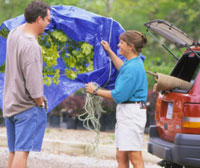 Be sure to securely wraptrees and other plants forthe trip home.
Be sure to securely wraptrees and other plants forthe trip home.
You've selected your plants and paid for them. Now how will you get them home? If you've purchased large trees, it's best to have the nursery deliver them, although you usually have to pay extra for this service. In the fall, however, nurseries often run specials. They are trying to sell a lot of stock so they don't have to provide winter care, and they may include delivery in your trees' purchase price. Here's another tip: If you've just bought $1,000 in plants, ask if the nursery will deliver gratis -- it never hurts to ask!
If you are hauling your own plants home, make sure you bring along a tarp and rope to cover them. Wind damage -- even if you only drive a few miles home at a very slow pace -- can permanently damage or kill your plants. Evergreens, especially, cannot tolerate dehydration of their needles.
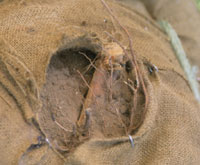 Avoid plants that have largeroots protruding from rotting burlap.
Avoid plants that have largeroots protruding from rotting burlap.
What to look for:
What to avoid:
What to avoid:
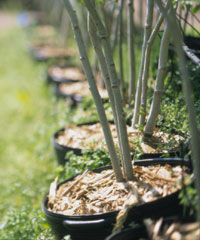 A light mulch helps retainmoisture in these container-grown shrubs.
A light mulch helps retainmoisture in these container-grown shrubs.
What to look for:
What to avoid:
Copyright © www.100flowers.win Botanic Garden All Rights Reserved